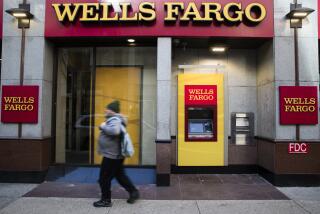Bank Profits in 1991 Best Since 1988 : Banking: The FDIC also believes the future looks good. It says no special infusion is needed for the deposit insurance fund.
WASHINGTON — Despite a troubled economy, the U.S. banking industry had profits of $18.6 billion last year, its best performance since 1988, the Federal Deposit Insurance Corp. said Monday.
“The current situation provides great hope,” FDIC Chairman William Taylor said after addressing the Institute of International Bankers. Much of the industry is “very healthy,” even in the face of a persistent recession and large write-offs for troubled real estate loans, he said.
Taylor discounted a gloomy forecast by the White House Office of Management and Budget projecting potential failures among some of the nation’s biggest banks.
The OMB estimate suggested that the federal deposit insurance fund would need to levy a special assessment of $3.9 billion on the nation’s banks to pay for the cost of failures after 1993. Accounts up to $100,000 are protected by the federal insurance fund.
But the FDIC forecast, based on its examination reports of banks, does not indicate a pressing need for a special infusion of funds.
The FDIC believes that no one can make accurate forecasts beyond two years, as the OMB attempts to do. “We think after you go beyond six quarters, the weight assigned to projections tends to drop off,” FDIC spokesman Alan Whitney said. “Based on what we see now, (a special assessment) is not necessary.”
The OMB “could prove to be right--if they do, it will be a good guess on their part,” Whitney said.
The FDIC already collects 23 cents per $100 of deposits for the insurance fund and is considering whether to increase the charge to 30 cents in July. Banks contend that an increase would be an unwarranted extra burden on an industry just beginning to recover.
The industry’s profits of $18.6 billion for last year compared to $16.7 billion in 1990. It was the best performance since 1988, when banks earned $24.8 billion. Since that high point, the industry has been plagued with massive write-offs for loans gone bad, first in its dealings with developing countries and later on commercial real estate.
“Most of the banks have gotten most of the problem loans behind them,” either by recording major losses or selling the loans, said Joe Belew, president of the Consumers Bankers Assn. In addition, “there have been some effective cost-control measures--organizations have gotten skinnier,” he said.
“It’s obviously good news,” said Virginia Dean, spokeswoman for the American Bankers Assn. Banks have set aside “a lot of additional reserves against losses,” she said. “If you do enough of it for long enough, finally things turn around and the numbers look better.”
Earnings were consistent last year in every quarter, indicating that there was no big surge in money set aside to cover real estate losses. In 1990, by contrast, earnings fell each quarter as banks struggled to cover growing real estate problems.
The banking industry’s operating income was $14.8 billion last year, virtually the same as the $15 billion earned in 1990, the FDIC reported. There was a gain of nearly $3 billion from securities transactions, with banks dealing in government and municipal debt securities. The gain from securities the prior year was just $480 million.
The improved profit picture for 1991 represents “the fruits of some conservative, prudent banking,” said Diane Casey, executive director of the Independent Bankers Assn.
“Hopefully, it’s a good indicator we are on the road to recovery,” she said. “It definitely sends a message (that) a deposit insurance premium increase is not needed now.” The possibility of a mid-year boost in premiums is “a huge concern for bankers,” said Dean of the American Bankers Assn. “If banks are on the comeback trail, and get slammed with a new premium boost, it can offset the impact of improved profits,” she warned.
More to Read
Inside the business of entertainment
The Wide Shot brings you news, analysis and insights on everything from streaming wars to production — and what it all means for the future.
You may occasionally receive promotional content from the Los Angeles Times.










